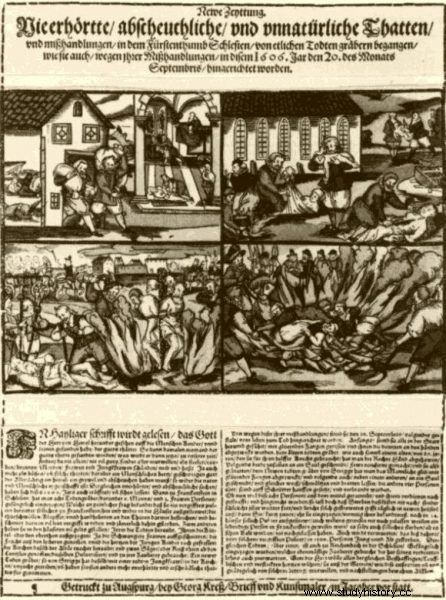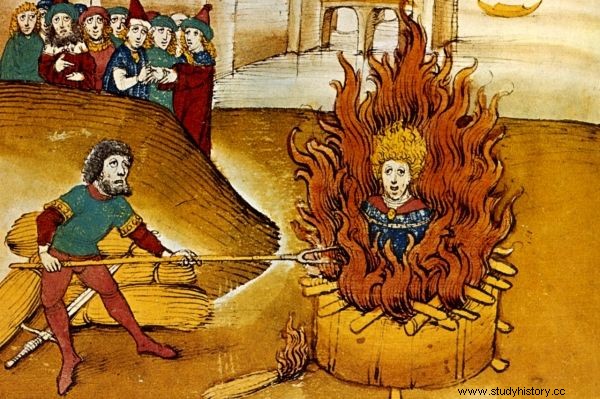One of the theories is that the inspiration for Mary Shelley and the story about Dr. Frankenstein could have been a macabre story that happened in today's Ząbkowice Śląskie in the 17th century. The town was then called Frankenstein and became famous because of the scandal in which the main characters were accused of witchcraft and plague. Did Silesian gravediggers eat human hearts and cut out fetuses from the bellies of dead women?
In 1606, the small town of Frankenstein (literally translated Kamień Franków, now Ząbkowice Śląskie in Lower Silesia) was struck by a plague, which killed over 30% of the town's inhabitants. A total of 2,061 people died then, of which a quarter were children. While the raging plague was not particularly surprising, the concept emerged that this particular plague was caused on purpose. The suspicions were directed at the local gravediggers.

Newe Zeyttung newspaper with woodcuts illustrating the gravediggers scandal
Gravedigger - Unclean Profession
This profession, like the profession of executioner, was not respected both in the Middle Ages and in modern times, and people associated with this specific industry were considered unworthy and unclean. So it was easy to associate the plague with local gravediggers. In the town chronicle, the mayor of Marcin Koblitz noted:
On September 10, 1606, two gravediggers from Ząbkowice were arrested - Wacław Förster, a gravedigger for 28 years, and his assistant Jerzy Freidiger from Strzegom, due to mixing and preparing poisons. Both were released by farmhand Förster.
On September 14, a certain Weiber - former prisoner and third gravedigger, Kacper Schleiniger - was arrested, and on September 16, 87-year-old beggar Kacper Schetts was arrested - all on charges of poisoning and spreading the plague.
On October 4, Zuzanna Maß - the daughter of the deceased city official Schubert, her mother - Magdalena Urszula, now the wife of the gravedigger Schleiniger, and Małgorzata - the wife of the beggar Schetts - were brought to prison.
The apartments of the accused were searched. Apparently, one of them had a jar of powdered medicine that was supposed to be made from a human corpse! Ultimately, eight people were accused of causing the plague, including six men and two women. But it didn't stop there ...
Torture and confession
Violent torture was a common practice in lawsuits at the time. As a consequence, the accused pleaded guilty. They were to tell in detail how they prepared the powder from the infected corpses, and then spread it on the doorsteps of houses, and smeared it on knockers and door handles. Moreover, each subsequent death provided them with material to prepare poison.
The suspects also admitted robbing churches and houses and desecrating the bodies. The description of the events was included in the city chronicle and was published in the Augsburg newspaper "Newe Zeyttung":
Those who, after being tortured in the investigation, testified that they had prepared poisoned powder and spread the same poisoned powder several times in their homes, smeared thresholds, knockers and door handles, which caused many people to poison themselves and die.
Besides, they stole a lot of money from their homes, and they stripped off the corpses by taking their coats from them. They also cut open pregnant women and took out their fetuses, and ate the hearts of young children raw. There they stole altar tablecloths from the churches, and two wind-up clocks were stolen from the pulpit.
further noted:
(...) They pulverized it and used it for their spells. A new gravedigger from Strzegom disgraced the body of a young virgin in the church . Others committed various unheard-of and terrible deeds (...)
It is difficult to say whether the gravediggers were actually guilty of any of the acts they confessed. Torture was extremely effective. The accused indicated other guilty parties and finally seventeen people took part in the trial!
The death penalty
All those brought to trial were sentenced to death. Worse still, it was supposed to be a punishment by burning, but preceded by mutilation . According to the verdict, the gravedigger who allegedly disgraced a virgin was castrated with red-hot pincers.
A very vivid description of the punishment was published in the already mentioned newspaper "Newe Zeytung":
First, they were all shown around the city. Then they were torn apart with red-hot pliers and their thumbs were torn off. The elderly gravedigger and one of the helpers, 87, had their right hands cut off. Then they were both chained together to a pole, fire was lit from a distance and baked. A male member was torn out of a new gravedigger from Strzegom with red-hot pincers. Then he and the others were chained to a pole, cooked and baked. The rest of the people were put on the stake and burned.
Although most of the revelations that the accused admitted had nothing to do with the truth, it is possible that there was a grain of truth in the story itself. Unfortunately, in retrospect, it is very difficult to establish what really happened and what was forced by cruel torture.

Burning at the stake was a fairly popular punishment
There is a theory that links the macabre story to the creation of the famous work of the young Mary Shelley. The name of Dr. Frankenstein and the idea of experimenting with fragments of bodies stolen from cemeteries are hardly coincidental. And we have already written about the second concept of creating an idea for a famous horror novel on our website.
